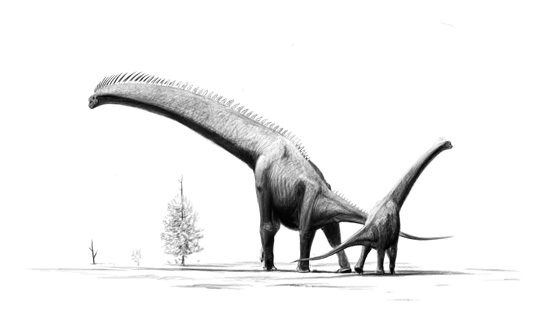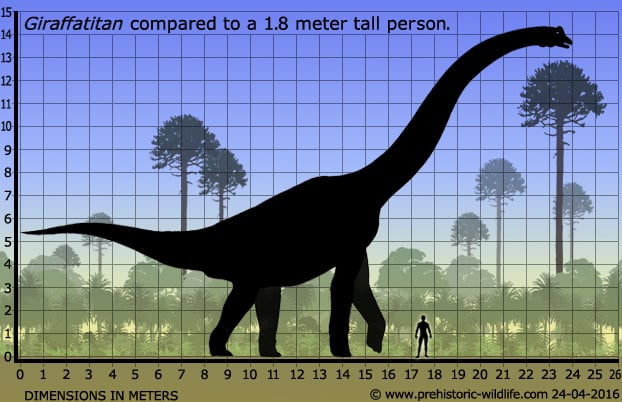[Recent Entries][Archive][Friends][User Info]
| October 22nd, 2012 | |
|---|---|
| 08:43 pm [industrialterro] [Link] |
Giraffatitan Жираффатитан (Giraffatitan brancai) — гигантский динозавр-зауропод из семейства брахиозавров. Описан в 1914 году Яненшем под названием Brachiosaurus brancai из позднеюрских (киммеридж) отложений Тендагуру на территории нынешней Танзании. Скелет был смонтирован в Берлинском музее Естественной истории и является самым высоким смонтированным скелетом динозавра. В отдельный род выделен Дж. Ольшевским в 1991 г., но это выделение не получило широкого признания и чаще новый род рассматривается в качестве синонима рода Brachiosaurus. Выделение рода жираффатитан обусловлено отличиями в строении черепа и скелета. От брахиозавра отличается также относительно лёгким телосложением. При длине около 25 метров весил лишь 15—30 тонн. Высота могла превышать 15 метров, но по современным данным, брахиозавры не могли держать шею вертикально. Таким образом, реальная высота головы над землёй была меньше. Высота в плечах у крупных особей составляла около 7 метров. В отличие от американского брахиозавра, известен по многочисленным скелетам разного размера (вёл стадный образ жизни). Характерен для нижних и средних слоёв отложений Тендагуру. Вероятно, питался листвой деревьев. Гребень на черепе выше, чем у американского вида, мог служить для терморегуляции или вокализации (на гребне могли быть закреплены кожистые голосовые мешки). Вряд ли умел хорошо плавать (как показано на старых реконструкциях) ввиду неуклюжести жирафоподобного телосложения и узких подошв стоп и кистей. В целом известен лучше, чем американский вид, часто изображается под названием «брахиозавр». Giraffatitan was a sauropod, one of a group of four-legged, plant-eating dinosaurs with long necks and tails and relatively small brains. It had a giraffe-like build, with long forelimbs and a very long neck. The skull had a tall arch anterior to the eyes, consisting of the bony nares, a number of other openings, and "spatulate" teeth (resembling chisels). The first toe on its front foot and the first three toes on its hind feet were clawed. Traditionally, the distinctive high-crested skull has been seen as a characteristic of the genus Brachiosaurus to which Giraffatitan brancai was originally referred, but because within the traditional Brachiosaurus material it is known only from Tanzanian specimens now assigned to Giraffatitan, it is possible that Brachiosaurus altithorax did not show this feature. For many decades, Giraffatitan was claimed to be the largest dinosaur known, (ignoring the possibly larger but lost Amphicoelias) but in the later part of the 20th century several giant titanosaurians (Argentinosaurus, Puertasaurus and Futalognkosaurus) appear to have surpassed Giraffatitan in terms of sheer mass. However, Giraffatitan, along with Brachiosaurus are still the largest dinosaurs known from relatively complete material. All size estimates for Giraffatitan are based on the specimen HMN SII, a subadult individual between 21.8–22.5 metres (72–74 ft) in length. Mass estimates are more problematic and historically have varied from as little as 15 tonnes (17 short tons) to as much as 78 tonnes (86 short tons). These extreme estimates are now considered unlikely due to flawed methodologies. More recent estimates based on models reconstructed from bone volume measurements, which take into account the extensive, weight-reducing air sac systems present in sauropods, and estimated muscle mass, are in the range of 23–37 tonnes (25–41 short tons). However, HMN SII is not the largest specimen known (an assertion suported by its subadult status) but HMN XV2, represented by a tibia 13% larger than the corresponding material on HMN SII, which might have attained 26 metres (85 ft) in length. Like other sauropods, Giraffatitan had a relatively small brain, when its massive body size is taken into account, of about 300 cm³. A 2009 study calculated its brain-to-body mass ratio (a rough estimate of possible intelligence) at a low 0.62 or 0.79, depending on the size estimate used. Giraffatitan is also similar to other sauropods in having an enlargement of the spinal cord above the hips, which some older sources misleadingly referred to as a "second brain". The placement of Giraffatitan nostrils has been the source of much debate with Witmer (2001) describing in Science the hypothesized position of the fleshy nostrils in Giraffatitan in as many as five possible locations. There has also been the hypothesis of various sauropods, such as Giraffatitan, possessing a trunk. The fact that there were no narrow-snouted sauropods (Giraffatitan included) tends to discredit such a hypothesis. Stronger evidence for the absence of a trunk is found in the teeth wear of Giraffatitan, which shows the kind of wear that would result from biting and tearing off of plant matter rather than purely grinding, which would be the result of having already ripped the leaves and branches off with its trunk. If Giraffatitan was endothermic (warm-blooded), it would have taken an estimated ten years to reach full size, if it were instead poikilothermic (cold-blooded), then it would have required over 100 years to reach full size. As a warm-blooded animal, the daily energy demands of Giraffatitan would have been enormous; it would probably have needed to eat more than ~182 kg (400 lb) of food per day. If Giraffatitan was fully cold-blooded or was a passive bulk endotherm, it would have needed far less food to meet its daily energy needs. Some scientists have proposed that large dinosaurs like Giraffatitan were gigantotherms. The nostrils of Giraffatitan, like the huge corresponding nasal openings in its skull, were long thought to be located on the top of the head. In past decades, scientists theorized that the animal used its nostrils like a snorkel, spending most of its time submerged in water in order to support its great mass. The current consensus view, however, is that Giraffatitan was a fully terrestrial animal. Studies have demonstrated that water pressure would have prevented the animal from breathing effectively while submerged and that its feet were too narrow for efficient aquatic use. Furthermore, new studies by Lawrence Witmer (2001) show that, while the nasal openings in the skull were placed high above the eyes, the nostrils would still have been close to the tip of the snout (a study which also lends support to the idea that the tall "crests" of brachiosaurs supported some sort of fleshy resonating chamber).
Размеры тела в сравнении с человеком:
Tags: Вымершие рептилии, Юра, авеметатарзалии, архозавроморфы, архозавры, брахиозавриды, диапсиды, динозавроморфы, динозавры, завроподоморфы, завроподы, макронары, титанозавроформы, ящеротазовые |







